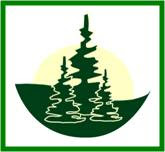 The photo above shows a crop tree release in a hardwood stand near Antigonish in Nova Scotia. By removing competing trees, the owner will promote growth and quality in the trees that are left standing. These trees were chosen because they are likely to have high value when mature.
The photo above shows a crop tree release in a hardwood stand near Antigonish in Nova Scotia. By removing competing trees, the owner will promote growth and quality in the trees that are left standing. These trees were chosen because they are likely to have high value when mature.The following first appeared in the "NSWOOA Update", an email newsletter published by the Nova Scotia Woodlot Owners and Operators Association. I'll be writing an item for this newsletter every month and will post a copy of the item here. The entire Update can be seen at the NSWOOA website.
There are two main approaches to forest management—even-aged management and uneven-aged management (UAM)—although sometimes people practice a mixture of the two. Ultimately the choice of which approach to use will depend on forest condition and management objectives, and can change over time because of circumstances (for instance, devastation caused by hurricane) and/or as management objectives change.
One important difference between UAM and even-aged management is that whereas even-aged management tends to focus on “stands” (conglomerations of similar-aged trees of similar species), UAM tends to focus on individual trees within a particular area, with a goal of growing high-quality trees that will have high value when harvested. This allows the woodlot owner to practice selection management, earning a continual modest income over time while maintaining other forest values such as wildlife habitat and recreation.
In contrast, with even-aged management, entire stands are likely to be cut at one time. This may produce a high financial return in the year the harvesting is done, but other values may be sacrificed and the stand may not produce income again for decades.
In UAM, areas within a woodlot are separated into management units based on ecological factors such as site and soil conditions, ecotype, and previous disturbance/harvest practices. A key consideration is the presence of potentially high-value trees (often referred to as crop trees) and potential for growing such trees.
Intermediate and mature crop trees are assessed based on considerations such as straightness/form, vigor, lack of limbs, lack of scars or other defects, and ultimately species marketability now and into the future. But it is also important to recognize potential crop trees that may be regenerating under canopy, particularly where openings have occurred allowing sunlight to penetrate to the forest floor. This requires knowledge of tree silvics (what our various native tree species need to grow and flourish), natural succession patterns (or stages of forest development from early to late stages), and the disturbance regime that is natural to the ecotype and ecodistrict where the woodlot is found within the Acadian Forest Region.
Here are some good resources on tree silvics and Acadian Forest ecosystems. The following can be purchased from the Nova Forest Alliance:
- Forest Ecosystem Classification of Nova Scotia’s Model Forest. An edition for the central region and interim versions for the eastern and western regions are available. A final version is expected in 2009.
- A Guide to Identifying and Managing Nova Scotia Hardwoods
The following are available free from various sources:
- Field Manual for Forest Ecosystem Classification. Although this is available for download, it is a very big file. Single copies of are available free of charge by writing to: Library, Dept. of Natural Resources , P.O. Box 698, Halifax, N.S. B3J 2T9; e-mailing nsdnrlib@gov.ns.ca; or from local offices of the Department of Natural Resources.
- Forest Soil Types of Nova Scotia: Identification, Description, and Interpretation. Available online, and single printed copies are also available free from the same source as the field manual listed above.
- Tolerant Hardwood Management Guide. Nova Scotia Department of Natural Resources Report FOR 2007-8 No. 84.
- Silvics of North America. Vol. 1: Conifers, Vol. 2: Hardwoods. 1990. Agriculture Handbook 654. U.S. Department of Agriculture, Forest Service.
- Interactive Guide to Common Trees of Nova Scotia.


No comments:
Post a Comment